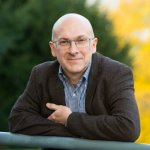11am - 12 noon BST
Monday 15 August 2022
Noise-induced transitions in gene expression and a novel and robust molecular switch actuating the quantitative model of eukaryotic cell cycle control
Free
This event has passed
Speakers

Dr Andrea Rocco
Associate Professor in Physics and Mathematical Biology
Biography
Andrea Rocco (MInstP, FHEA, FRSB) graduated in Physics at the University of Pisa (Italy) in 1994, discussing a thesis in quantum field theory. In 1998 he obtained his PhD in Physics from the University of North Texas (USA), where he focused on the role of stochastic processes in classical and quantum mechanical systems.
Between 1998 and 2007 Andrea held postdoctoral positions at the University of Barcelona (Spain), the University of Rome "La Sapienza" (Italy), CWI (The Netherlands), and the University of Oxford (UK). During this period of time, his research spanned several areas, from the general fields of statistical mechanics and pattern formation to the modelling of biological systems. In 2007 he obtained a Lectureship in Applied Mathematics at the University of Bath (UK), where he taught mathematical biology modules at both MSc and undergraduate levels.
In 2009 Andrea joined the University of Surrey (UK), where he is now Associate Professor (Reader) in Physics and Mathematical Biology, with a shared appointment between the School of Biosciences and the School of Mathematics and Physics.

Dr Matteo Barberis
Faculty Theme Leader for Infection and Immunity, Faculty Coordinator of Centre for Mathematical and Computational Biology (CMCB), and Reader in Systems Biology
Biography
Matteo started to work on cell cycle control during his master thesis and early PhD in the laboratory of Lilia Alberghina at the University of Milano-Bicocca (Italy), where he was interested to investigate biochemical mechanisms through which cellular activators and inhibitors regulate biochemically the onset into DNA replication in budding yeast. He then moved to the Max Planck Institute for Molecular Genetics in Berlin (Germany), in the laboratory of Edda Klipp, to complete his PhD and translate his experimental research into computational modeling through generation of mathematical models of the eukaryotic cell cycle. He then did a six year Postdoc at both the Max Planck Institute for Molecular Genetics and the Humboldt University in Berlin with Edda Klipp, where he developed as a systems biologist by integrating computational modeling and experimental strategies to uncover novel molecular mechanisms driving a timely cell cycle. In 2013, he then started his independent group as Assistant Professor of Synthetic and Systems Biology at the University of Amsterdam (The Netherlands), where he expanded his investigations to explore how molecular switches drive gene regulation dynamics in cell cycle control and in immune responses, such as those governed by T and mast cells. In December 2018, he joined the University of Surrey as Reader in Systems Biology, with the aim to unravel design principles of cellular organization, and develop multi-scale frameworks to understand how properties of biochemical systems emerge from the integration of multiple regulatory layers. His multi-faceted interests also expands to build cellular maps for network-based drug design, with a particular emphasis on cell physiology and disease.
Altogether, Matteo aims to unravel design principles of cellular organization by integrating computational modeling and molecular biology, in order to predict, test and validate experimentally molecular mechanisms underlying emergent properties of biological systems. He uses yeast and mammalian cells to investigate how dynamics switches timely control the eukaryotic cell division cycle. Furthermore, Matteo is also interested to develop multi-scale frameworks and tools to understand how properties of biological systems emerge from the integration of multiple layers of cellular regulation.
Overview
This event will feature two talks:
Noise-induced transitions in gene expression
Speaker: Dr Andrea Rocco, University of Surrey
Noise-induced transitions have been largely investigated in a variety of chemical, physical, and biological systems. These may occur when the system is affected by so-called extrinsic noise, representing for instance a fluctuating environment. Extrinsic noise can produce highly non-trivial effects, such as the ‘creation’ of stable states, and can lead to the emergence of multistability or oscillatory behaviours in systems deterministically monostable.
In this talk, I will review two fundamentally different mechanisms that have been identified to account for the emergence of noise-induced transitions. The first one is a consequence of the noise being linear, Gaussian, and “white”, namely characterized by fast fluctuations. The second mechanism, usually referred to as “nonlinear noise filtering”, is instead based on the noise being very slow, non-Gaussian, and nonlinear. I will propose some recent results obtained in my group, which provide a dynamical derivation of the noise filtering approach, and are based on a perturbative time-scale expansion of the relevant dynamics.
I will illustrate these different mechanisms by using the repressed gene as a simple but fundamental model of gene regulation, and highlight that the emergence of noise-induced transitions appears to be strongly dependent on the type of noise adopted, and on the degree of nonlinearity present in the system.
Finally, I will comment on possible evolutionary implications of these results.
A novel and robust molecular switch actuating the quantitative model of eukaryotic cell cycle control
Speaker: Dr Matteo Barberis, University of Surrey
The eukaryotic cell cycle is driven by waves of cyclin-dependent kinase (cyclin/Cdk) activities that rise and fall with a timely pattern called “waves of cyclins”. This pattern guarantees coordination and alternation of DNA synthesis with cell division, and its failure results in altered cyclin/Cdk dynamics and abnormal cell proliferation. Although details about transcription of cyclins are available, the network motifs responsible for this timely pattern are currently unknown.
Here I show a novel principle of design that ensures cell cycle time keeping through interlocking transcription with cyclin/Cdk dynamics in budding yeast. Through analyses of kinetic models of the cyclin/Cdk network and quantitative data of Clb dynamics, a novel regulatory design is unravelled that highlights the Clb/Cdk–TF axis being pivotal for timely cell cycle dynamics. This work rationalizes the quantitative model of Cdk control proposed by the 2001 Nobel Prize recipient Sir Paul Nurse, identifying regulatory motifs underlying cell proliferation dynamics in eukaryotes.
